What Color House Numbers Show Best at Night
Night sky, Feb 2022: What you can see this month [maps]
A articulate night sky offers an ever-changing display of fascinating objects to see — stars, constellations, and vivid planets, often the moon, and sometimes special events similar falling star showers. Observing the night sky tin be done with no special equipment, although a sky map tin can exist very useful. Binoculars or one of the best telescopes will heighten some experiences and bring some otherwise invisible objects into view. Yous can also utilize stargazing apps and software to make your observing easier, and use our Satellite Tracker page powered past N2YO.com to notice out when to meet the International Space Station and other satellites. Beneath, detect out what's up in the night sky tonight (Planets Visible Now, Moon Phases, Observing Highlights This Month) plus other resources (Skywatching Terms, Dark Sky Observing Tips and Further Reading).
You can also capture the dark sky by using whatsoever of the best cameras for astrophotography, along with a selection of the all-time lenses for astrophotography.
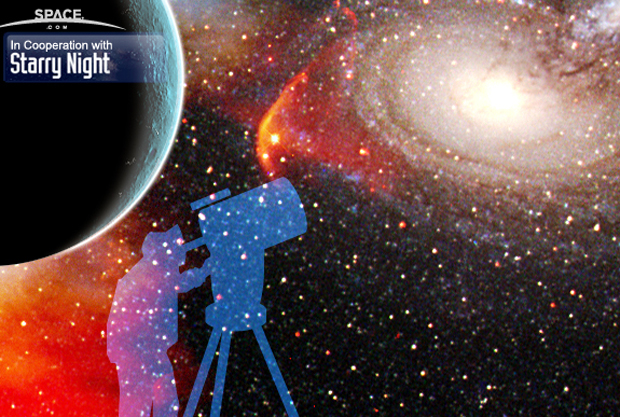
Monthly skywatching information is provided to Space.com by Chris Vaughan of Starry Dark Education, the leader in space science curriculum solutions. Follow Starry Nighttime on Twitter @StarryNightEdu and Chris at @Astrogeoguy.
Editor's note: If you have an astonishing skywatching photo y'all'd like to share for a possible story or image gallery, you lot tin can ship images and comments in to spacephotos@infinite.com.
Night Sky Guides:
- When, where and how to meet the planets in the 2022 dark sky
- The superlative skywatching events to look for in 2022
- Best dark heaven events of February 2022 (Stargazing Maps)
- Space calendar 2022: Rocket launches, heaven events, missions & more than
Calendar of observing highlights
Tuesday, Feb. 1 — New moon (at 05:46 GMT)
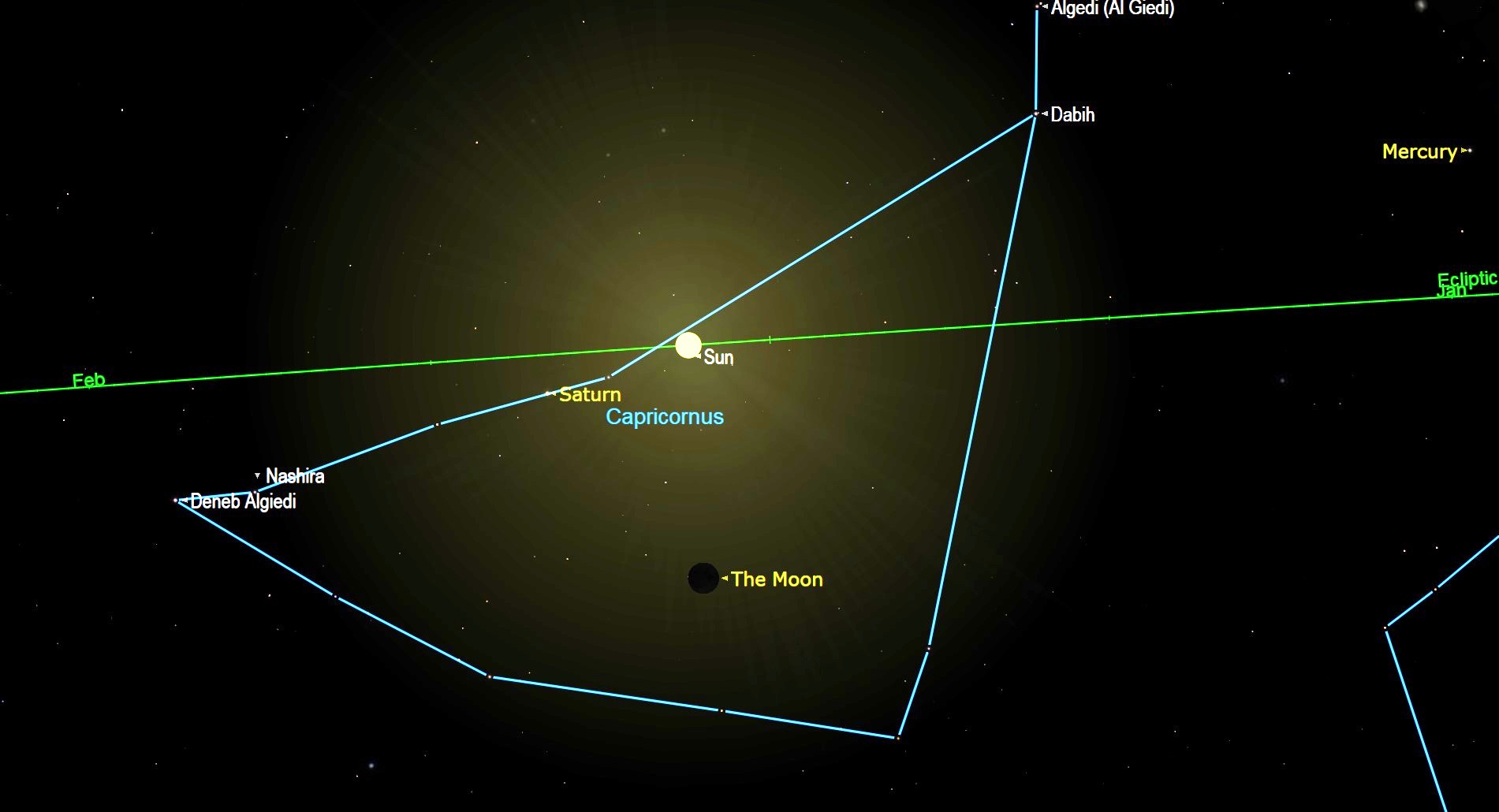
At 12:46 a.thousand. EST or 05:46 GMT on Tuesday, February. one, the moon will officially accomplish its new moon stage. At that time it will be located approximately 5.1 degrees s of the lord's day, in Capricornus. While new, the moon is traveling between Earth and the sun. Since sunlight can only reach the far side of a new moon, and the moon is in the aforementioned region of the sky as the sun, our natural satellite becomes completely hidden from view for about a day.
Tuesday, February. 1 — Mars passes Messier 28 (pre-dawn)
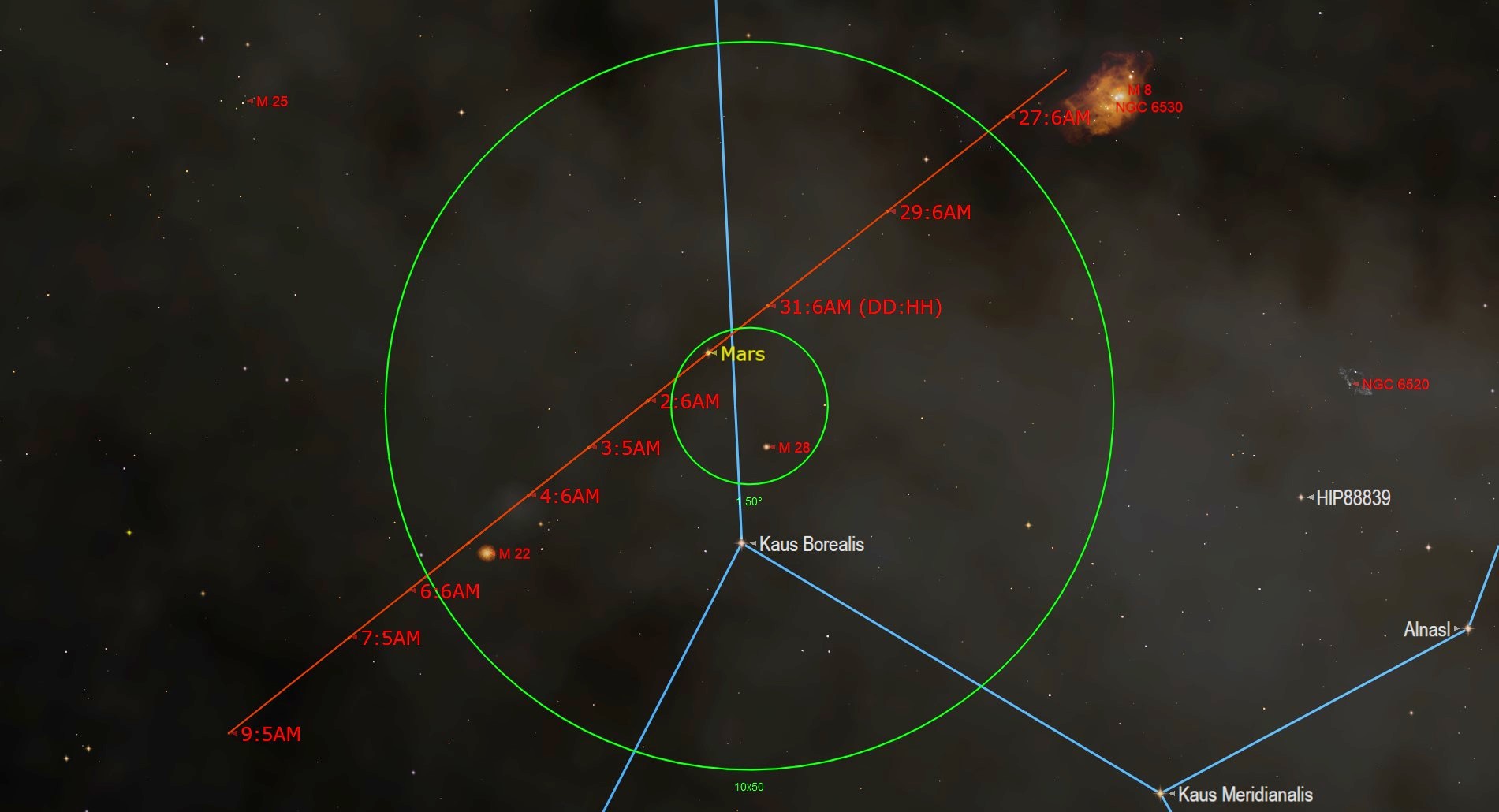
In the southeastern pre-dawn sky for several mornings centered on Tuesday, Feb. i, the orbital motility of Mars (red path with dates:hour) will carry the planet past the globular star cluster known as Messier 28. The cluster sits simply above the star, Kaus Borealis, which forms acme of the hat of Sagittarius' teapot-shaped star pattern. They'll be binoculars-shut (large green circle) for about a week — simply at closest approach on Tuesday, Mars will smoothen only a finger'due south width above (or 1 degree to the celestial north of) the cluster, allowing both objects to share the view in a lawn telescope (small dark-green circle). To see the cluster more easily, endeavour to view the duo before the sky begins to brighten. Observers at southerly latitudes will accept a meliorate view of the scene because Mars and Messier 28 will be college, and in a darker sky. On Friday, Feb. eleven, Mars will pass closely to the due south of some other, smaller globular cluster designated NGC 6717.
Wednesday, February. ii — Very young moon about Jupiter (afterwards sunset)
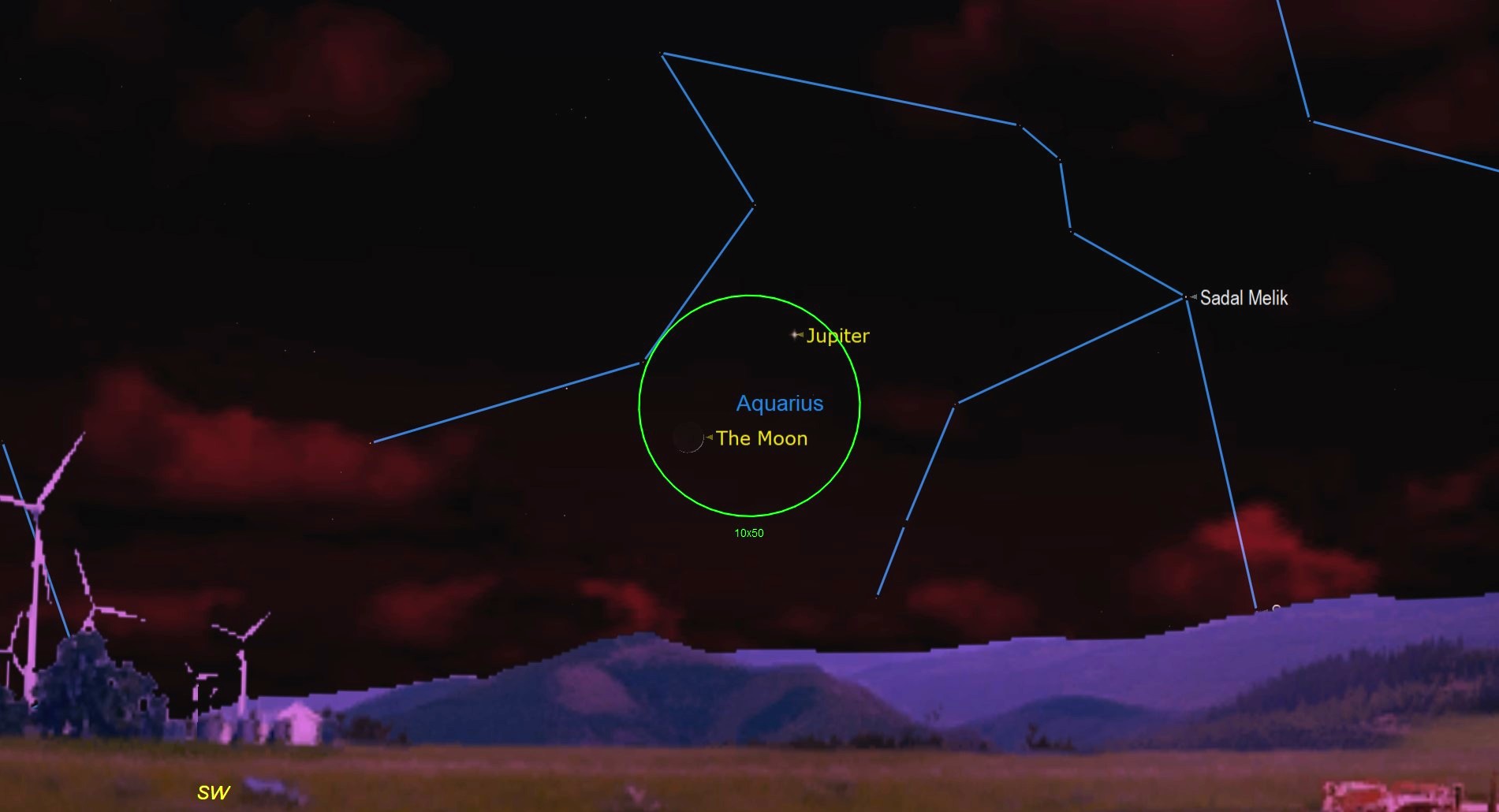
On Wednesday, Feb. two, a short distance to a higher place the westward-southwestern horizon, the very thin crescent of the young moon will shine several finger-widths to the lower left (or 4.6 degrees to the celestial SSW) of the brilliant planet Jupiter; close enough for them to share the view in binoculars (green circle). The duo will set around 7 p.g. local fourth dimension; merely try to view them equally soon equally the sky begins to darken, when they will exist higher, and shining through less distorting atmosphere.
Saturday, Feb. 5 — Mars attacks the Not bad Sagittarius Cluster (pre-dawn)
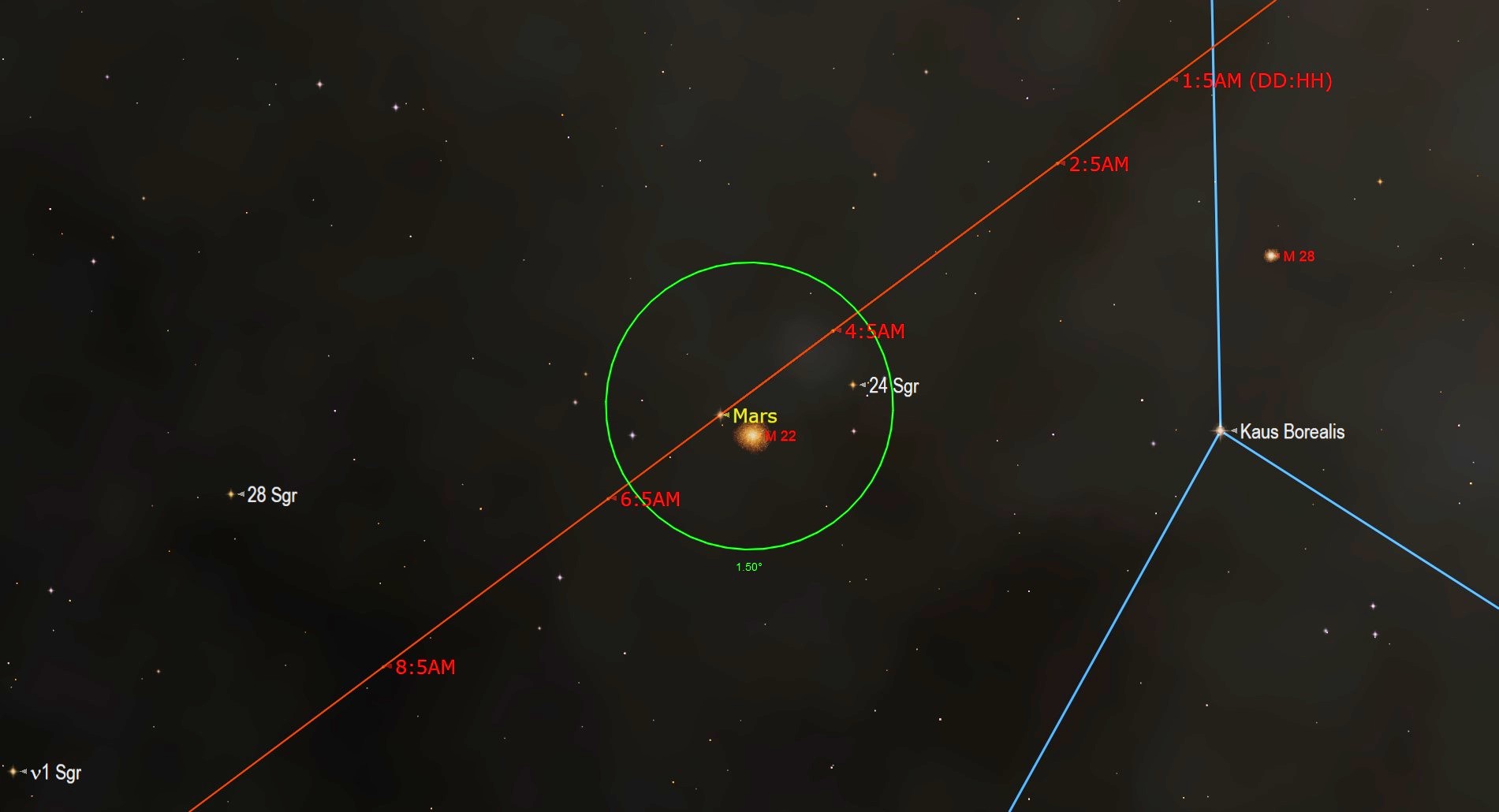
In the southeastern pre-dawn sky on Saturday, February. 5, the orbital move of Mars (reddish path with dates:hour) volition bear the planet through the outskirts of the large, vivid globular star cluster known as the Great Sagittarius Cluster and Messier 22. The coming together will make for a terrific telescopic photo opportunity. Messier 22 is located just two finger widths to the left of the star Kaus Borealis, which forms the height of the chapeau of Sagittarius' teapot-shaped star blueprint. Both objects volition share the view in a lawn telescope (small green circle) from Friday to Sunday; merely at closest approach on Sat, Mars will sit just 0.2 degrees to the celestial northward of the cluster. To see Messier 22 more easily, attempt to view the duo before the sky begins to burnish. Observers at southerly latitudes, where the pair will be college, and in a darker sky, volition accept a better view.
Sunday, Feb. six — Lunar libration reveals elusive oceans (evening)
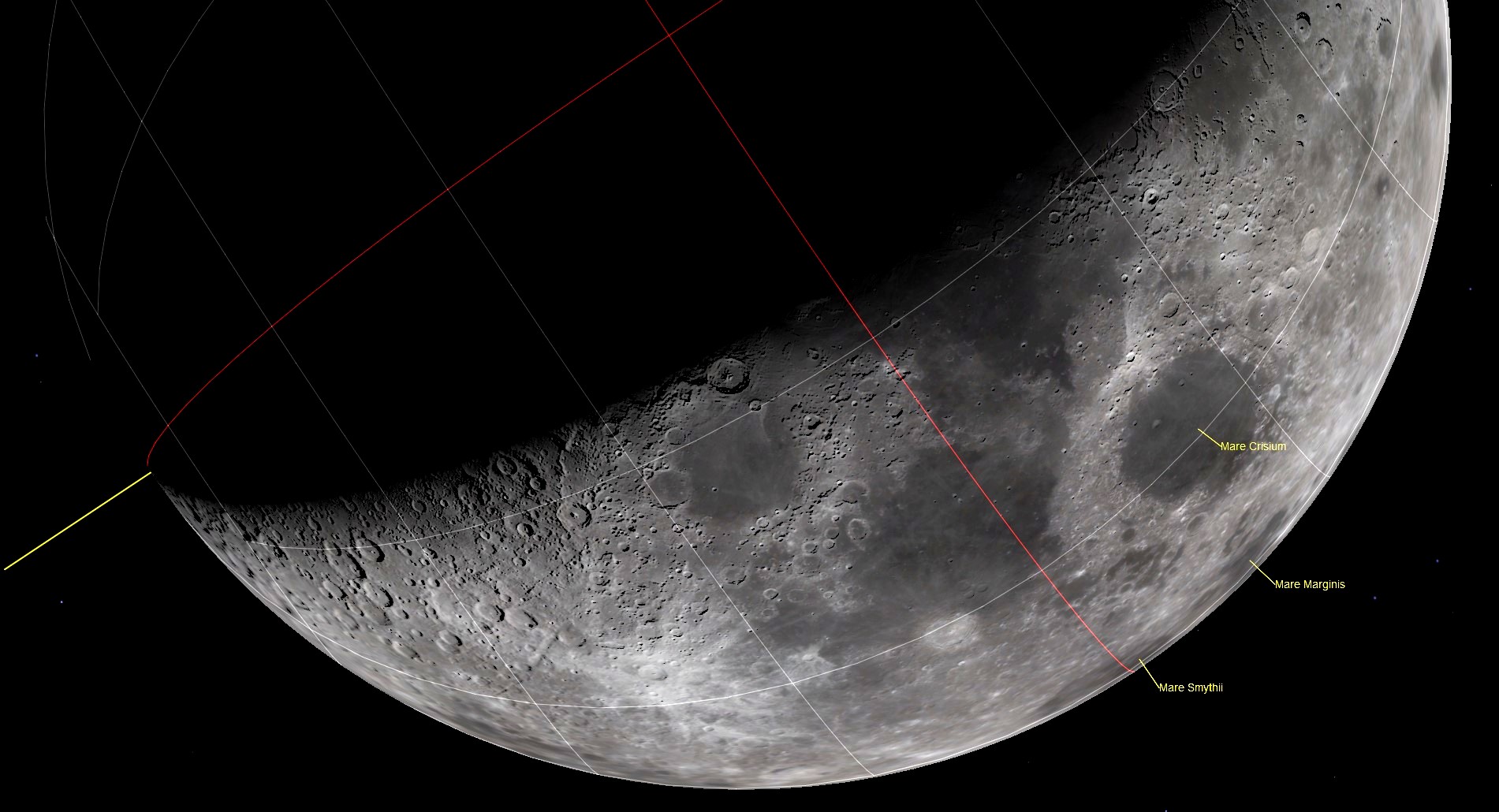
Due to its orbital inclination and ellipticity, the moon tilts up-and-down and sways left-to-right up past to a half-dozen degrees while keeping the same hemisphere pointed towards World at all times. Over time, this lunar libration consequence lets united states run across 59% of the moon's total surface without leaving the Earth. You tin can observe libration by noting the way major features motion toward and abroad from the limb of the moon, and up and downward. Mare Crisium is a 345 mile (556 km) diameter basin that is easy to see using your unaided eyes, and in binoculars, and telescopes. It is located well-nigh the eastern edge of the moon, just north of the moon's equator (the up-down red bend). On Sun, Feb. 6, libration will shift Crisium farther from the moon'due south right-mitt (eastern) edge. On the same evening, await closely for two dark patches positioned betwixt Mare Crisium and the moon'southward edge. Those maria, named Smythii and Marginis, are difficult to run across unless the moon'southward eastern limb is rotated towards Earth.
Monday, February. 7 — Half-moon passes Uranus (evening)
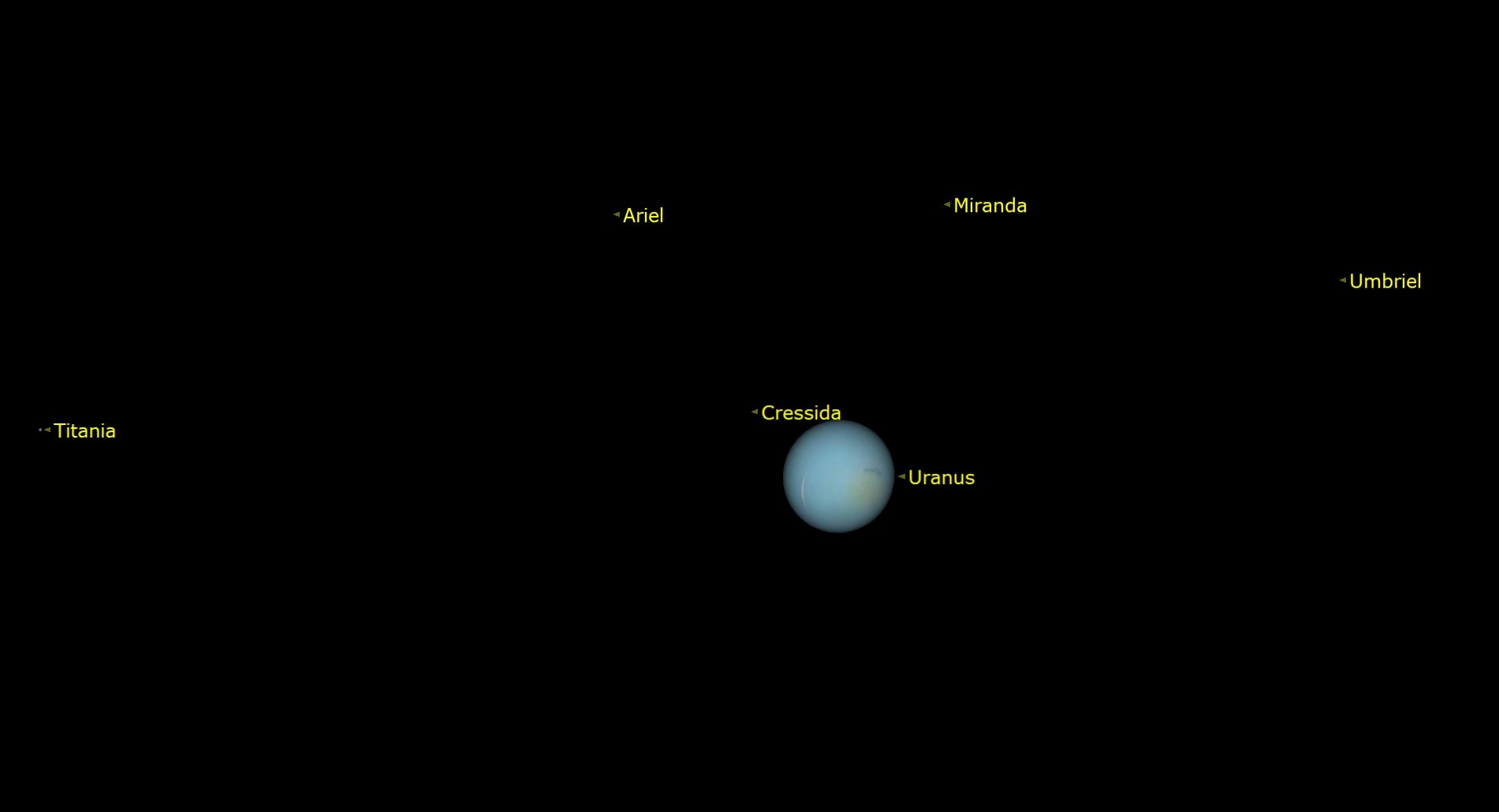
On Mon evening, Feb. 7, the orbital motion of the nearly half-illuminated moon will conduct it closely by the magnitude 5.78 planet Uranus. After dusk, use binoculars (green circle) to scan for Uranus sitting less than two finger-widths to the right (or one.8 degrees to the celestial northwest) of the moon. During the residual of the evening, the moon volition shift farther from the planet, and the diurnal rotation of the heaven volition lift the moon to a higher place Uranus. Several hours earlier, effectually 19:39 GMT, observers in the southern Atlantic Ocean near Queen Maud Land can come across the moon occult Uranus. Once the bright moon has left the scene on subsequent nights, you tin can use the brilliant stars Menkar in Cetus and Hamal and Sheratan in Aries to find Uranus.
Tuesday, Feb. 8 — First quarter moon (at thirteen:50 GMT)

When the moon completes the outset quarter of its orbit effectually Globe at eight:50 a.k. EST (or 13:50 GMT) on Tuesday, Feb. 8, the relative positions of the Earth, sun, and moon will crusade u.s. to see our natural satellite half-illuminated — on its eastern side. While at beginning quarter, the moon always rises around noon and sets effectually midnight, allowing it to be seen in the afternoon daytime sky, too. The evenings surrounding first quarter are the best for viewing the lunar terrain when it is dramatically lit by low-angled sunlight.
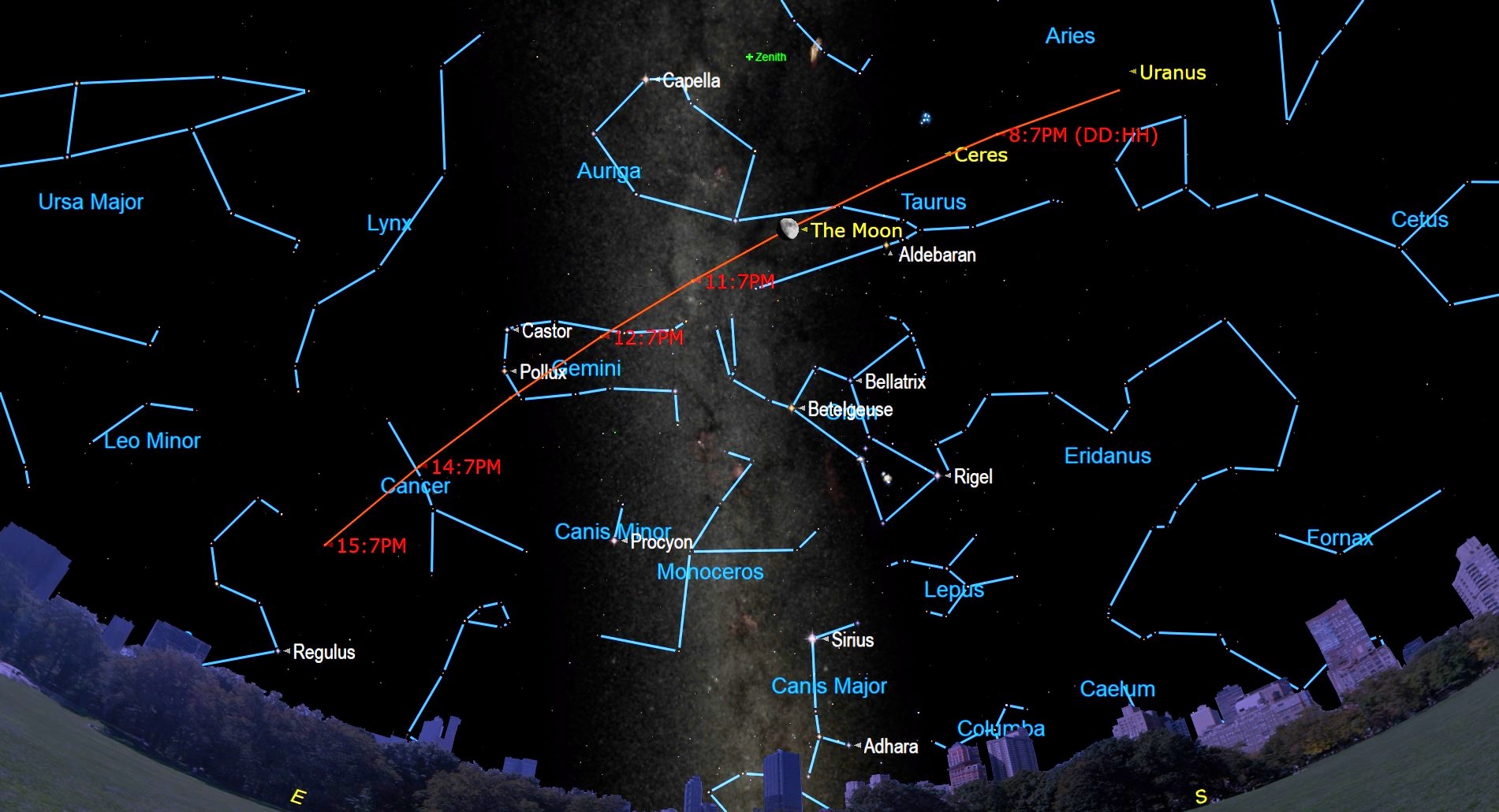
The Winter Football, also known as the Winter Hexagon and Wintertime Circumvolve, is an asterism composed of the brightest stars in the constellations of Canis Major, Orion, Taurus, Auriga, Gemini, and Canis Pocket-sized — specifically Sirius, Rigel, Aldebaran, Capella, Brush & Pollux, and Procyon. Viewed subsequently dusk from mid-Northern latitudes, the huge pattern will stand upright in the southeastern heaven — extending from 30 degrees above the horizon to overhead. The Galaxy passes vertically through the asterism. The hexagon is visible during evenings from mid-November to spring every year. The waxing gibbous moon volition cross the giant shape from Thursday, February. 10 to Saturday, February. 12 (red path with dates:hour).
Friday, Feb. eleven — Vivid moon near Messier 35 (all night)
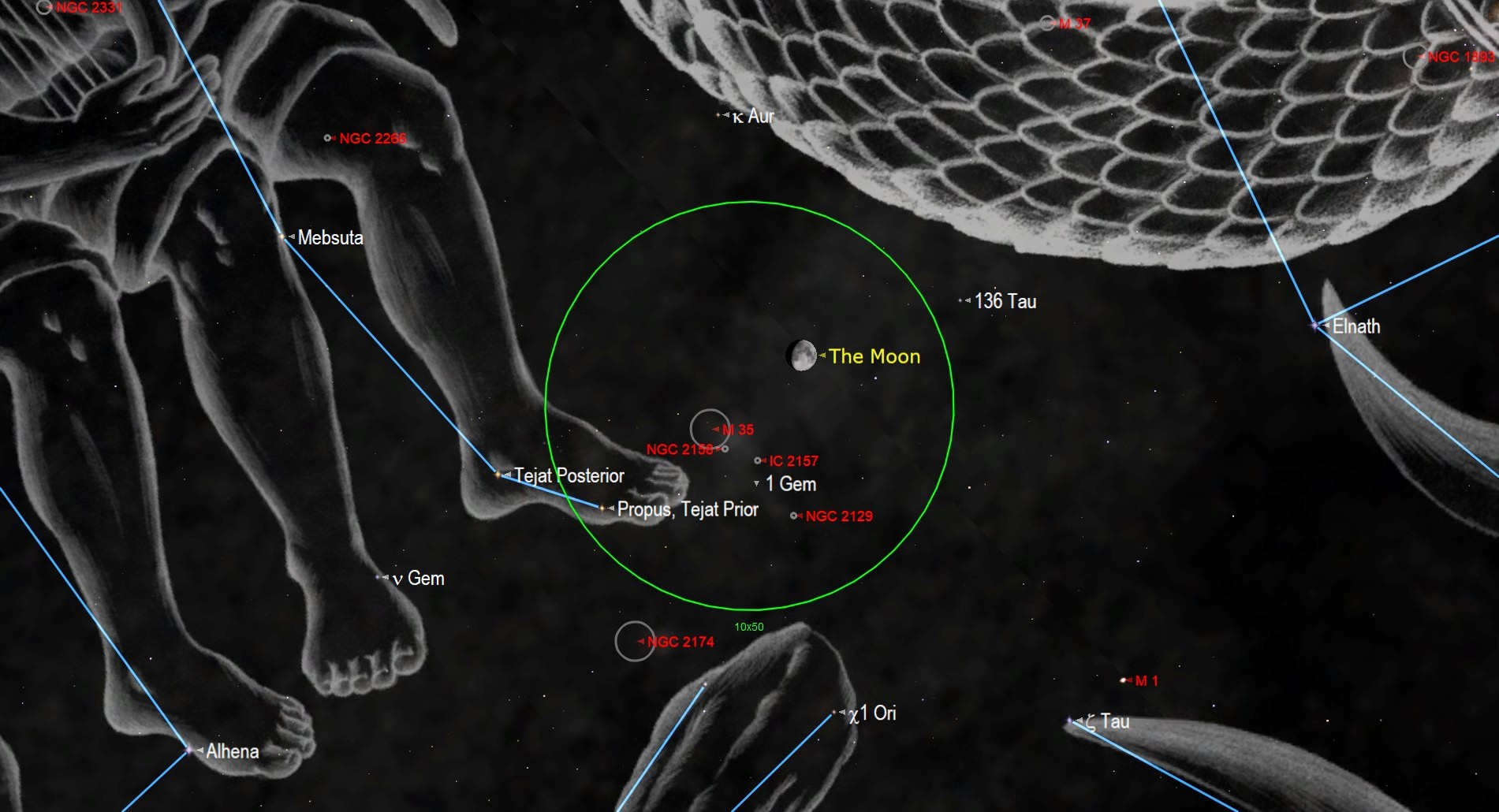
On Friday dark, Feb. eleven, the orbital motion of the waxing gibbous moon will conduct information technology just to a higher place (to the angelic north of) the large and bright open up star cluster in Gemini known every bit Messier 35, or the Shoe-Buckle Cluster, which sits near the vivid toe-star Propus. After sunset, when the cluster'due south stars volition get visible in binoculars (green circle), the moon will be poised about two finger-widths in a higher place (or 2.two degrees to the angelic northwest of) the cluster. By the time of their closest approach effectually one a.m. Eastern Time, 10 p.m. Pacific Fourth dimension or 06:00 GMT, the pair will be shut enough to share the view in a backyard telescope. At that time, the diurnal movement of the sky will take shifted the moon to the upper right of the cluster. To ameliorate meet the Shoe-Buckle'south stars, hide the moon just across the field of view of your binoculars or lawn telescope.
Saturday, Feb. 12 — Venus at greatest illuminated extent (pre-dawn)

On Sat, February. 12, Venus will accomplish its greatest illuminated extent for the current morning time bogeyman. In a telescope, the planet will show a 26%-illuminated, waxing crescent stage and an apparent deejay size of 41 arc-seconds. Even with a less than fully-illuminated disk (inset), Venus' distance from Earth of only 0.413 Astronomical Units (38.39 million miles or 61.78 million km) volition heave its brightness to a brilliant magnitude -iv.86. After ascent at about 4:30 a.chiliad. local time, Venus will be visible in the southeastern pre-dawn sky near the teapot-shaped constellation of Sagittarius and just a palm's width to the upper left of reddish Mars. Venus will appear nigh as bright on the post-obit morn.
Sunday, February. 13 — Venus veers toward Mars (pre-dawn)

During the second half of February and much of March, the brilliant planets Mars and Venus will polish together in the southeastern sky between well-nigh 5 a.chiliad. local fourth dimension and dawn. At magnitude -4.86, the white dot of Venus volition outshine cherry-red Mars by 300 times! Starting this weekend, the ii planets volition become binoculars-close (green circle). Each morning, the gap betwixt them will decrease slightly (red paths with labeled date:hour). At the same fourth dimension, the magnitude 7.65 main belt asteroid designated (iv) Vesta will be situated several finger-widths to the left (or 3 degrees to the celestial northeast) of Mars, and Mercury will exist hugging the horizon.
Monday, Feb. 14 — Bright moon passes the Beehive (all night)
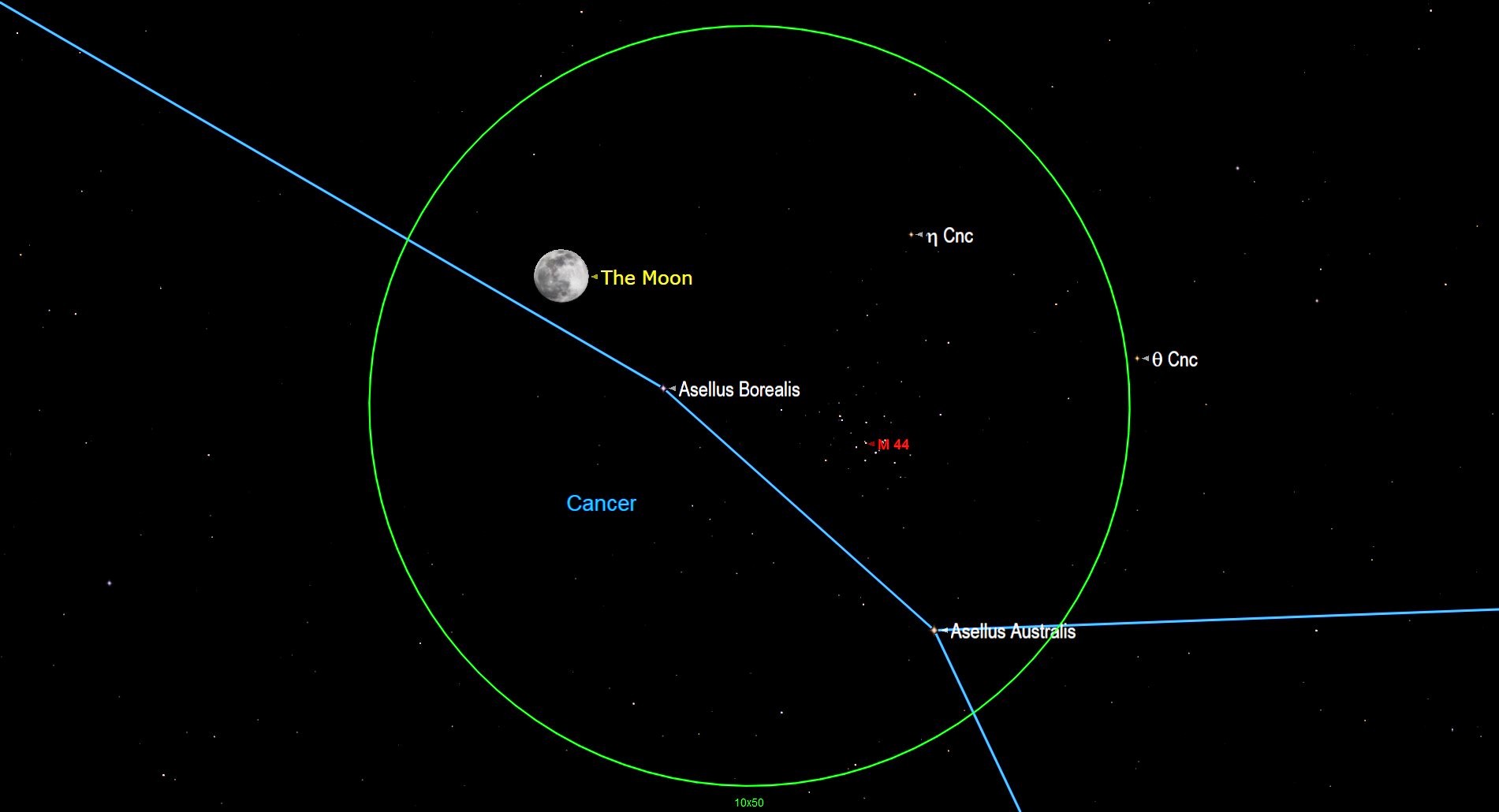
After dusk on Monday, February. xiv, the nearly full moon will exist positioned several finger-widths to the upper left (or 3 degrees to the celestial north) of the large open up star cluster known as The Beehive (or Messier 44) in the constellation of Cancer. Encounters between M44 and the moon or planets occur frequently because the cluster is located only one degree n of the ecliptic (green line). The moon and the Beehive will both fit inside the field of view of binoculars (dark-green circumvolve), but the moon'south brilliance will mostly overwhelm the cluster's stars. To meet more of them, try hiding the moon only outside your optics' field of view. During the dark, the diurnal rotation of the sky volition shift the moon above the Beehive.
Tuesday, Feb. 15 — Bluish Mare Tranquillitatis (all dark)
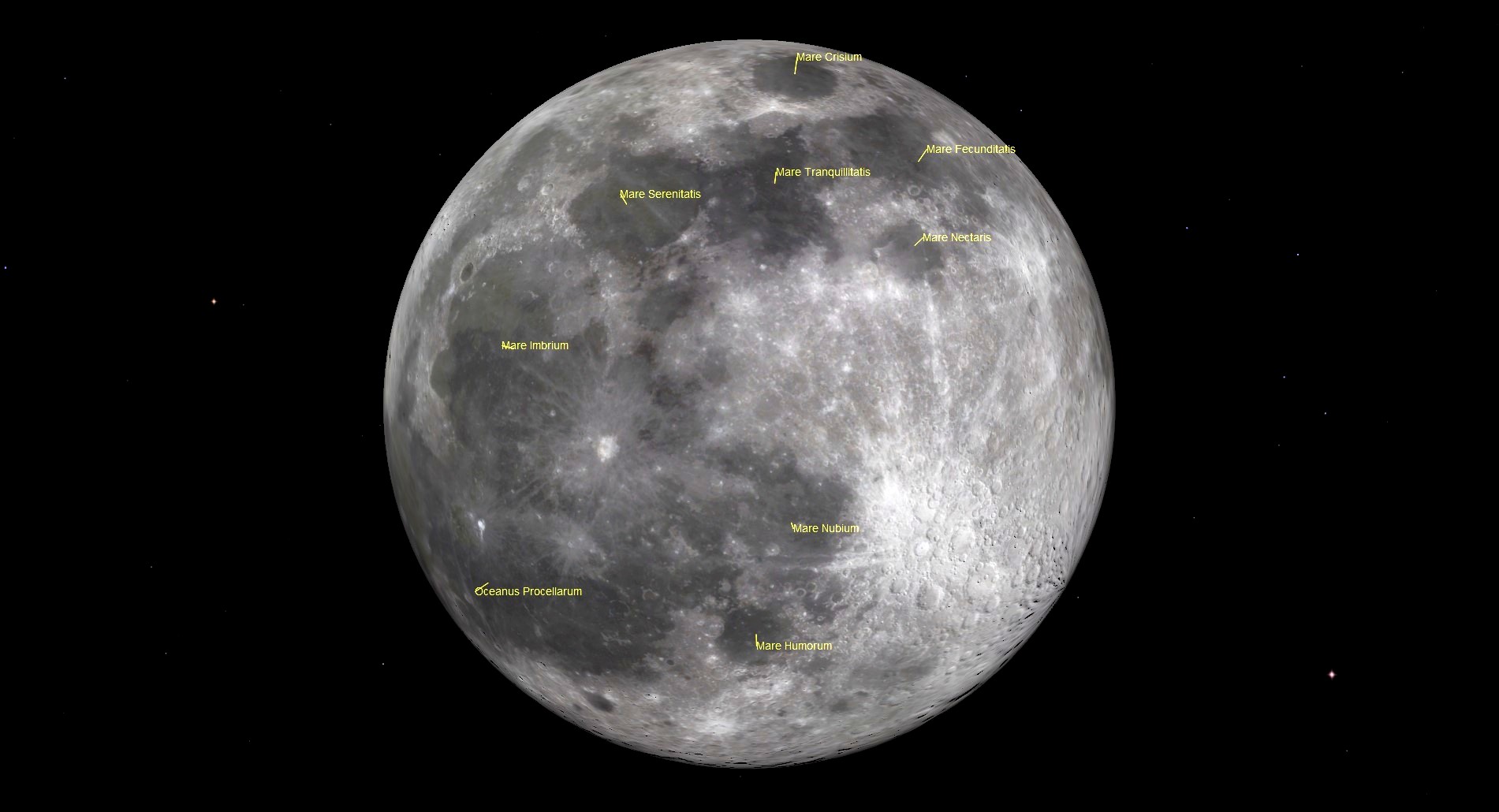
The maria, Latin for "seas", are the large, dark regions visible on the moon's near side. They are basins excavated by major impactors early in the moon'due south geologic history and subsequently infilled with dark basaltic rock that upwelled from the interior of the moon. Several maria link together to form a curving chain across the northern half of the moon's near-side. Mare Tranquillitatis, where humankind first walked upon the moon, is the large, round mare in the center of the concatenation. Sharp-optics might notice that this mare is darker and bluer than the others, due to enrichment in the mineral titanium. (To help remember the lunar directions, the westward side of the moon is illuminated at Last Quarter.)
Wednesday, Feb. xvi — Full Snow Moon (at 16:56 GMT)

The February total moon will occur on Wednesday, Feb. 16 at 11:56 a.thousand. EST or 16:56 GMT. The indigenous Anishnaabe (Ojibwe and Chippewa) people of the Great Lakes region phone call the February full moon Namebini-giizis "Sucker Fish Moon" or Mikwa-giizis, the "Bear Moon". For them information technology signifies a fourth dimension to discover how to see beyond reality and to communicate through energy rather than sound. The Algonquin call it Wapicuummilcum, the "Ice in River is Gone" moon. The Cree of Northward America call it Kisipisim, the "the Great Moon", a time when the animals remain hidden abroad and traps are empty. For Europeans, it is known as the Snow Moon or Hunger Moon. Since information technology's contrary the lord's day on this twenty-four hour period of the lunar calendar month, the moon is fully illuminated, and rises at sunset and sets at sunrise. When full, no shadows are bandage by the lunar terrain — so all of the albedo variations are produced by the moon's geology. February moons culminate very high in the nighttime heaven and cast shadows similar to summer midday sun.
Wednesday, February. 16 — Mercury at greatest western elongation (pre-dawn)
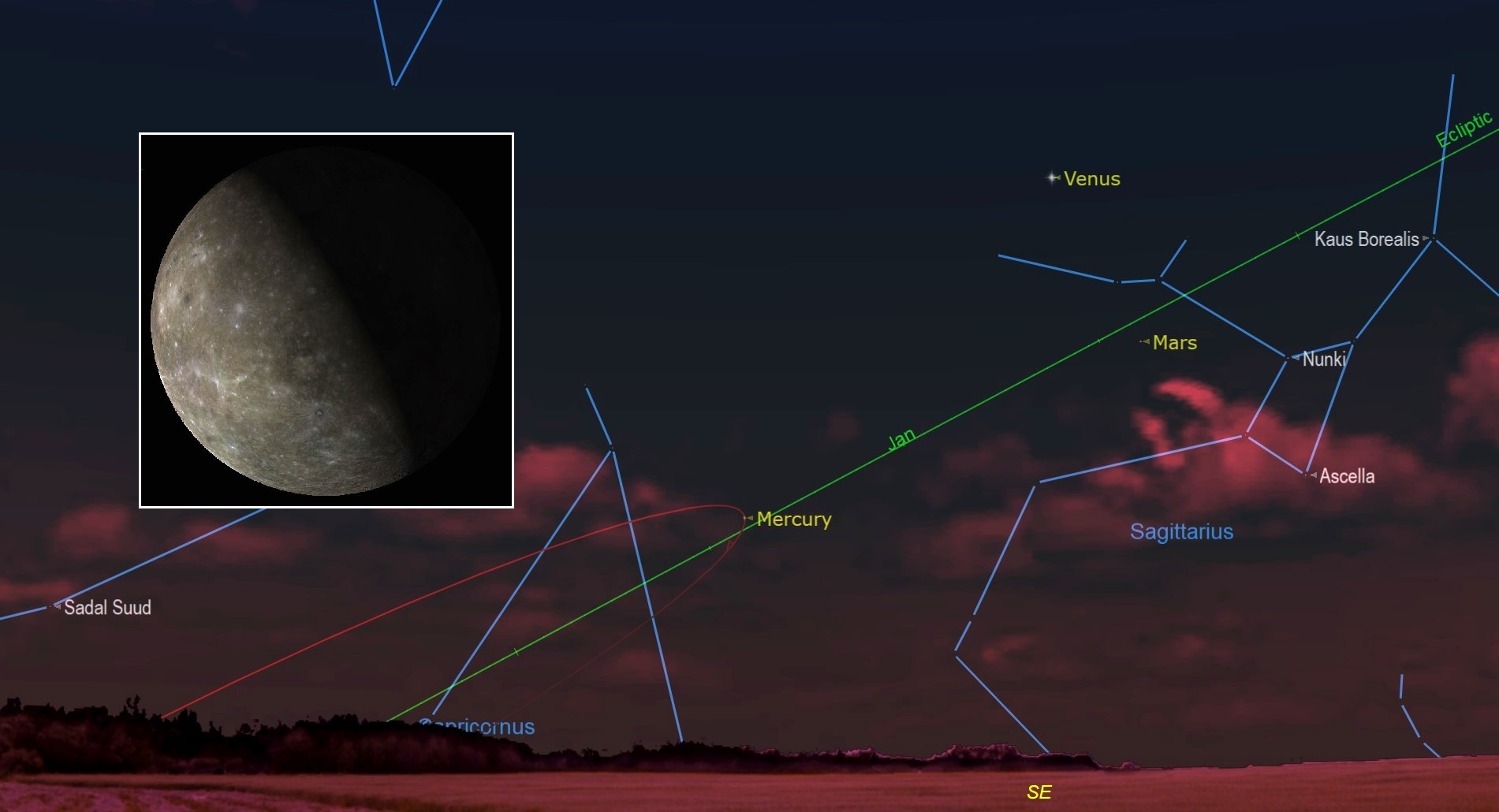
On Wednesday, Feb. 16, Mercury will reach its widest bending of 26° west of the sun, and peak visibility for its current forenoon apparition. Starting effectually 6:xxx a.one thousand. in your local fourth dimension zone, await for the planet shining very low in the southeastern sky. It will be positioned 1.4 fist diameters to the lower left of much brighter Venus and fainter Mars. In a telescope (inset) Mercury will exhibit a 59%-illuminated, waxing gibbous phase. Mercury's position most the shallowly-dipping morning time ecliptic (green line) will brand this a poor apparition for mid-Northern latitude observers, but a fine showing for those located virtually the Equator, and further south. Mercury will exist virtually as far from the dominicus on the surrounding mornings.
Fri, February. xviii — Limb libration reveals Mare Orientale (all night)

Due to its orbital inclination and ellipticity, the moon tilts upward-and-downwardly and sways left-to-correct up by to a half-dozen degrees while keeping the same hemisphere pointed towards Earth at all times. Over fourth dimension, this lunar libration effect lets us encounter 59% of the moon's total surface without having to leave the World. On Friday night, Feb. eighteen, the western limb of the moon will be rotated towards Earth, revealing the edge of Mare Orientale, the youngest of the moon'due south slap-up basins. Its name "the Eastern Ocean" belies its location on the moon's western hemisphere. To see it, use binoculars or a telescope to first seek out the nighttime circular crater named Grimaldi and the very bright crater Byrgius to its south. Mare Orientale will be a darkened strip hugging the edge of the moon and centered between those two craters.
Sabbatum, Feb. xix — Evening Zodiacal Low-cal (subsequently dusk)

If yous live in a location where the heaven is free of light pollution, you might be able to spot the Zodiacal Lite, which will appear during the two weeks that precede the new moon on Wednesday, March two. Later on the evening twilight has disappeared, you'll have about half an hour to bank check the western sky for a broad wedge of faint light extending upward from the horizon and centered on the ecliptic. That glow is the zodiacal low-cal — sunlight scattered from endless minor particles of material that populate the plane of our solar arrangement. Don't confuse it with the brighter Milky way, which extends up from the northwestern evening horizon at this time of year.
Tuesday, Feb. 22 — Moon occults double star Zubenelgenubi (pre-dawn)
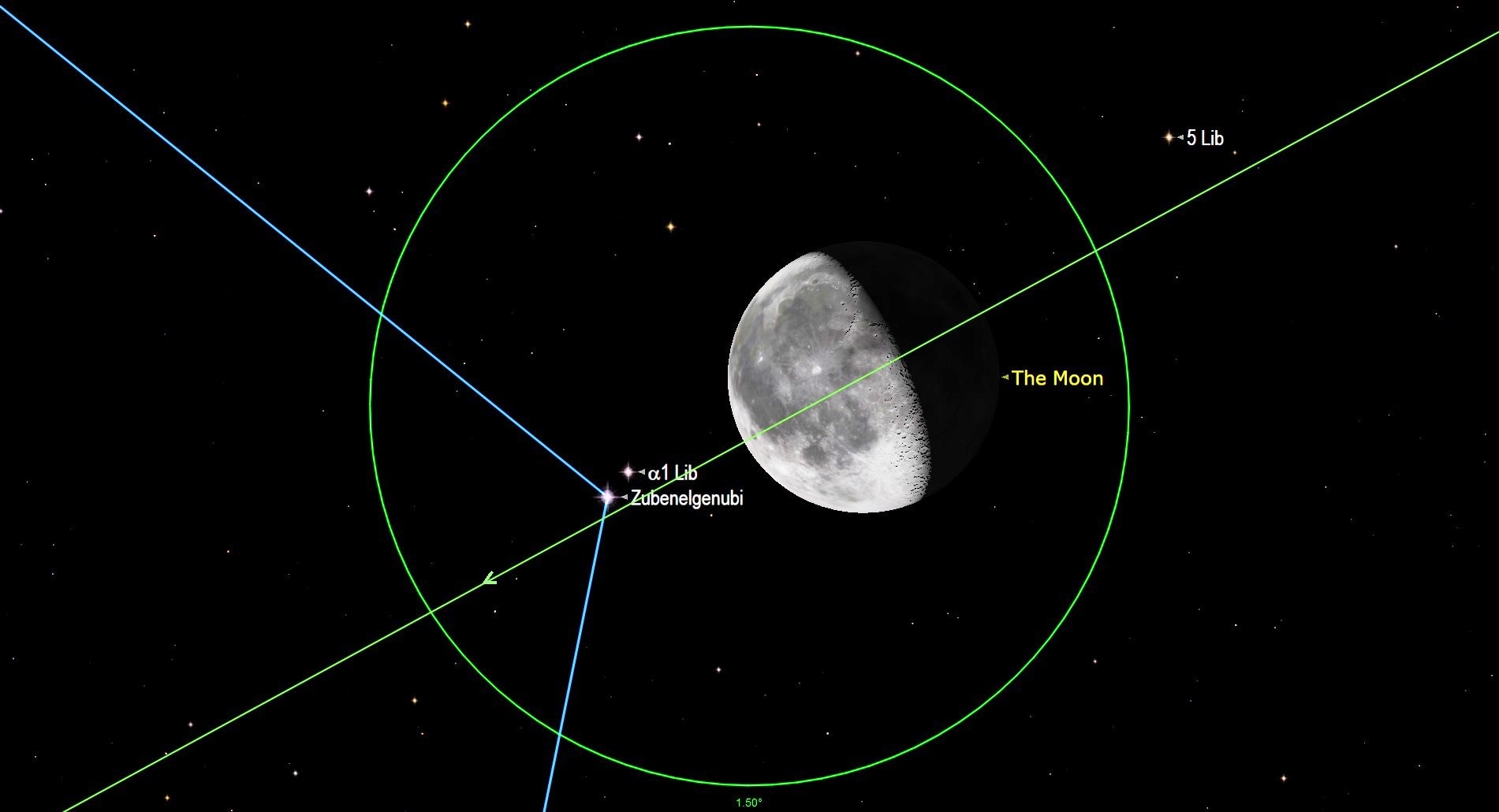
On Tuesday forenoon, Feb. 22, observers with binoculars and lawn telescopes (green circle) in much of Mexico, the USA, and western Canada can picket the moon occult the bright double star designated Alpha1,2 Librae, or Zubenelgenubi I and Ii. Surrounding regions volition see the moon pass very close to those two stars, which are always separated by about one/ten of the moon'south diameter. The start and end times for the upshot vary past location. Use an astronomy app like Starry Night to look up the times for your site. In Dallas, Texas, the bright leading edge of the moon will cover the first star at v:25 a.m. CST or xi:25 GMT, and the second star volition disappear eight minutes subsequently. Alpha1 Librae will sally from behind the dark limb of the moon at 6:33 a.yard. CST or 12:33 GMT, followed by its partner at 6:44 a.thou. CST or 12:44 GMT. For best results, outset watching several minutes alee of each of the times quoted.
Wednesday, Feb. 23 — Third quarter moon (at 22:32 GMT)
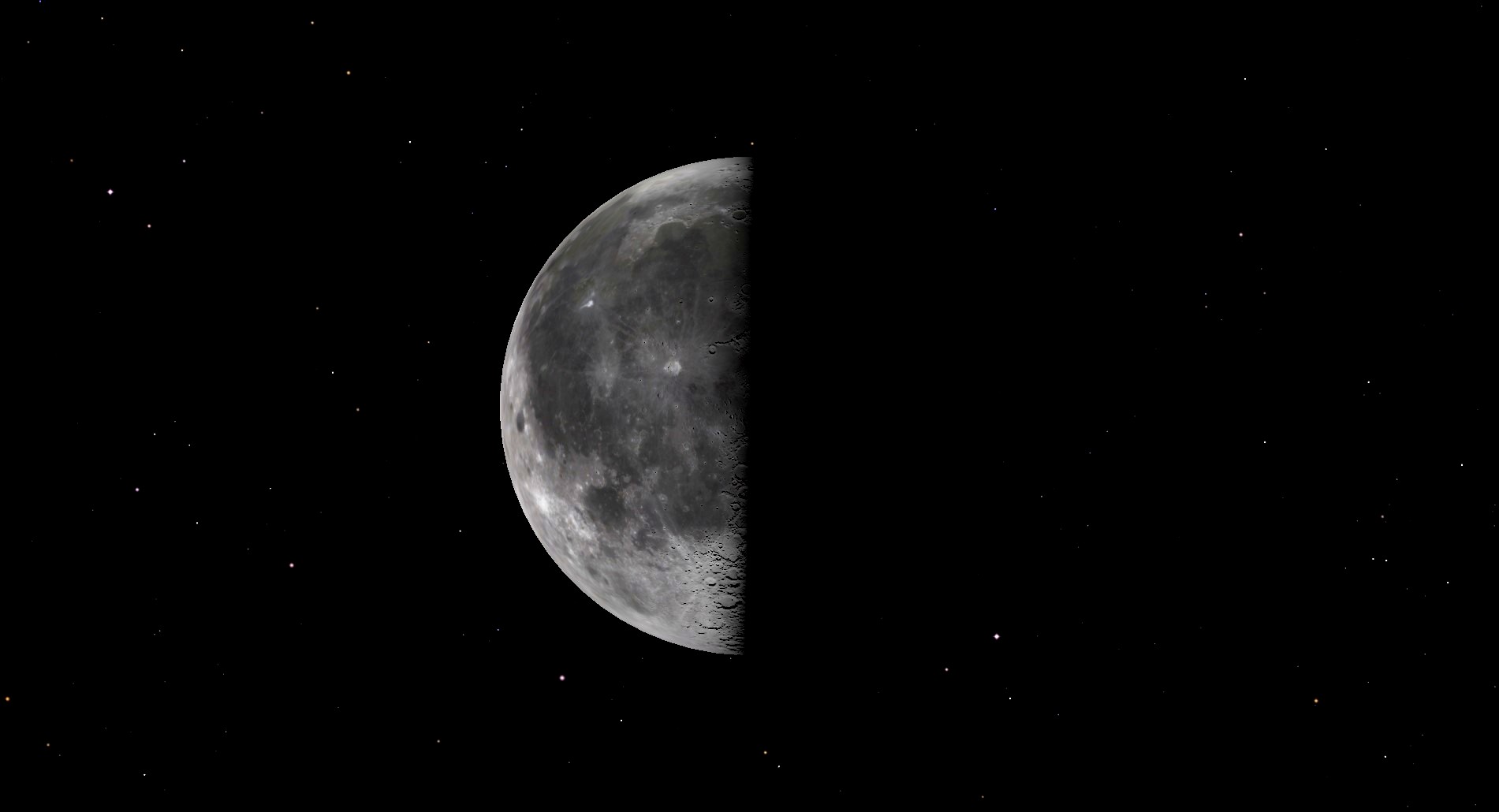
When the moon reaches its third quarter stage at 5:32 p.k. EST or 22:32 GMT on Wednesday, Feb. 23, information technology will rise at about midnight, and and so remain visible in the southern sky all forenoon. At third, or concluding, quarter the moon is illuminated on its western side, towards the pre-dawn Lord's day. Third quarter moons are positioned ahead of the Earth in our trip around the Lord's day. About 3½ hours later, Earth will occupy that same location in space. The week of dark, moonless evening skies that follow this stage will be platonic for observing deep heaven targets.
Thursday, Feb. 24 — Crescent moon near Antares (pre-dawn)
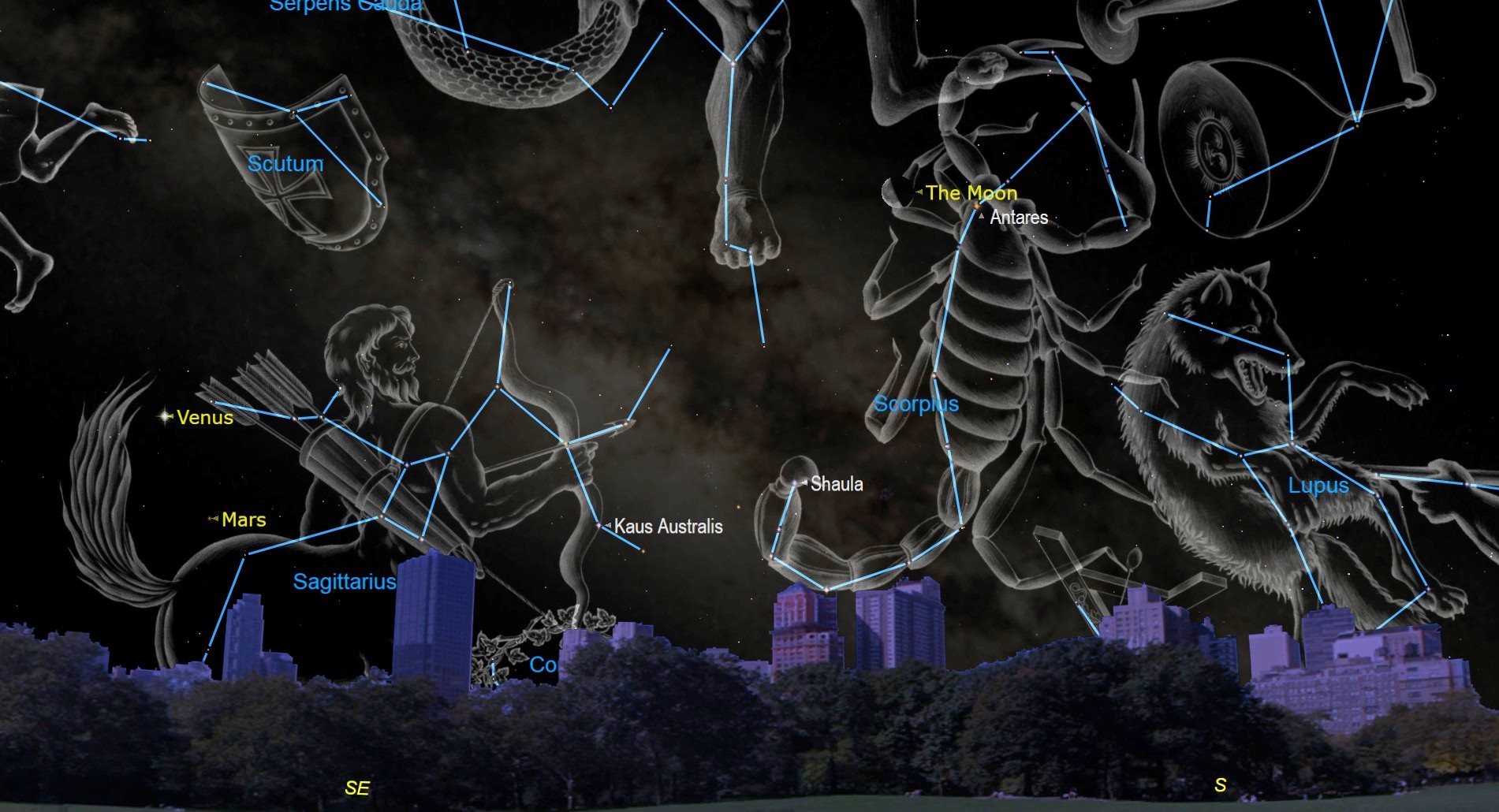
When the waning crescent moon rises over the southeastern horizon shortly earlier ii a.m. local time on Thursday, Feb. 24, it volition be perched two finger-widths to the left (or 3 degrees to the celestial northeast) of Mars' "rival", the bright, reddish star Antares in Scorpius. The scorpion's claw stars will extend to the right (west) of the duo, while stars of its body and tail will descend below them (angelic south). Include the bright planets Mars and Venus shining off to their left to etch a nice wide-field photograph. By the time that the heaven has brightened enough to hibernate Antares, around 6 a.yard. local time, the moon will accept climbed to Antares' upper left.
Sunday, Feb. 27 — Old moon, Mars and Venus align (pre-dawn)
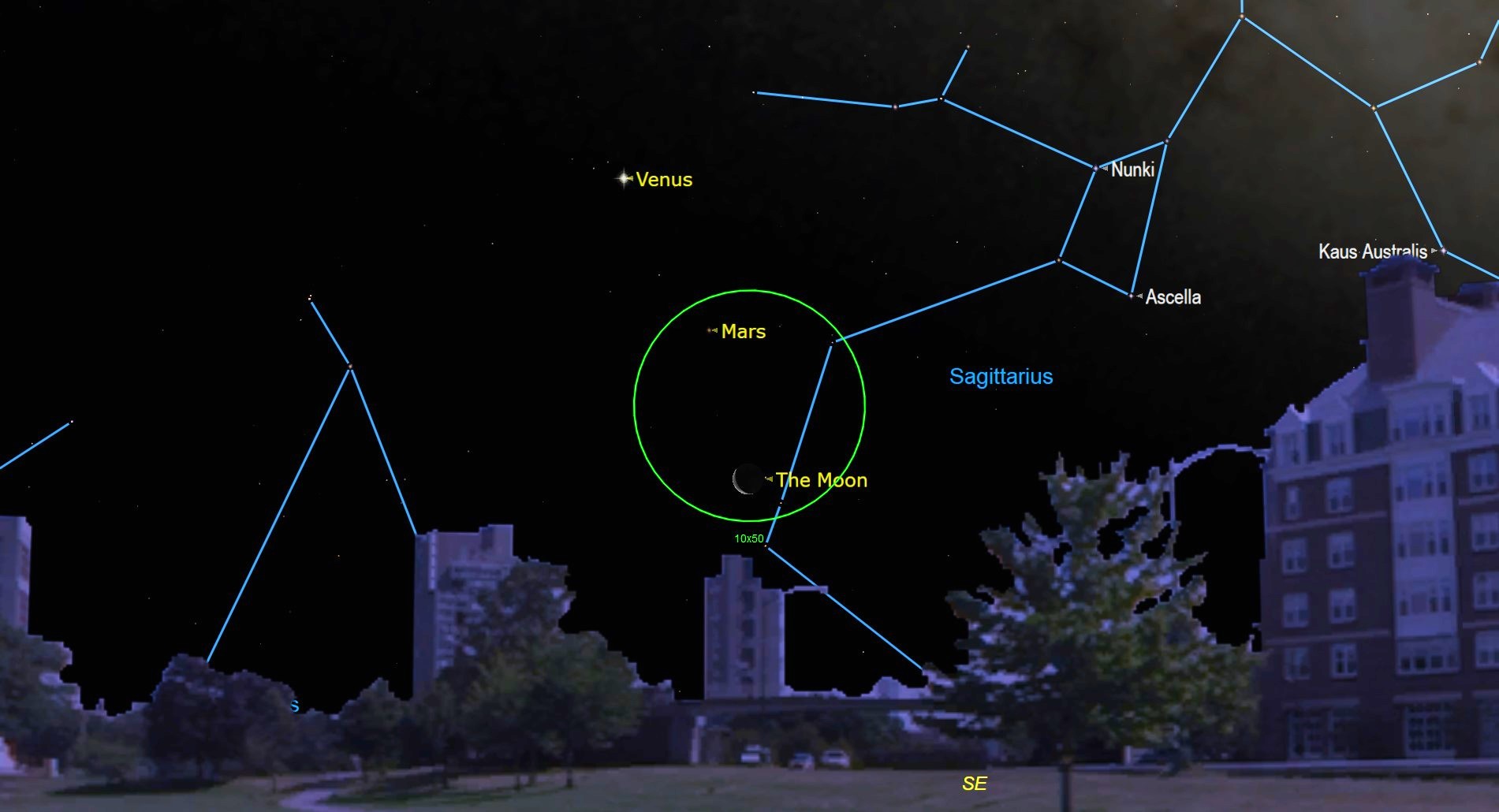
In the southeastern pre-dawn heaven on Sunday morning, Feb. 27, the old crescent moon will form a neat line with extremely bright Venus at the tiptop and much fainter, reddish Mars in the middle, making a terrific photo opportunity when equanimous with some interesting mural. The fist-wide organisation won't allow all three objects to share the view in binoculars (greenish circumvolve), but Venus and Mars or Mars and the moon, will. Even after magnitude i.26 Mars fades into the brightening sky, the moon and magnitude -iv.75 Venus will remain visible — until almost sunrise.
Mon, Feb. 28 — Crescent moon with Mercury and Saturn (earlier sunrise)
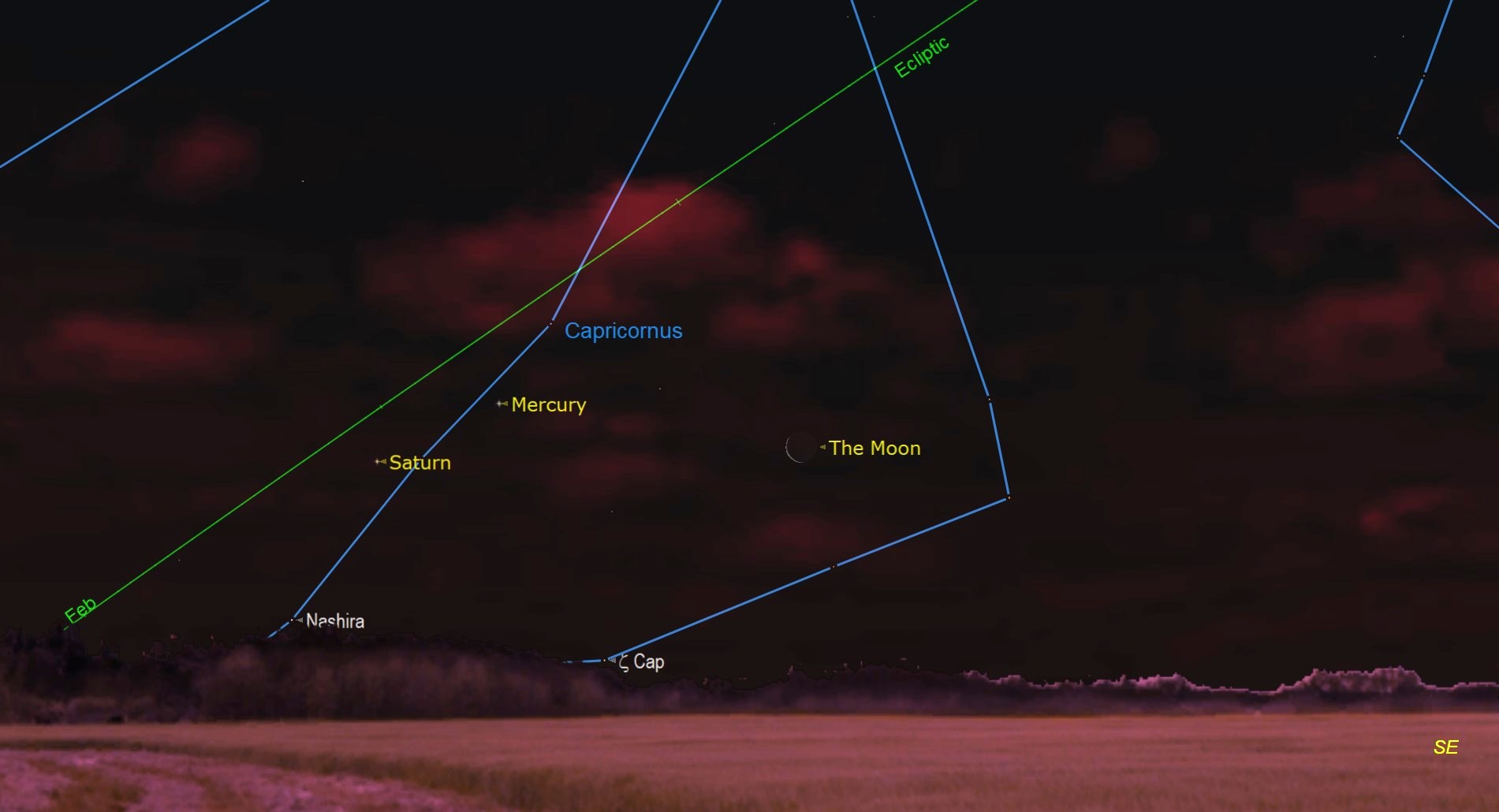
Wait just in a higher place the east-southeastern horizon before sunrise on Monday, February. 28 to see the slim crescent of the old, waning moon shining a palm'south width to the lower correct (angelic southwest) of the planets Mercury and Saturn. The trio will be higher, and in a darker heaven, for observers in the tropics and at southerly latitudes, where the ecliptic (light-green line) will exist more vertical. Scout for the bright planets Mars and Venus shining about ii fist diameters to the celestial west of the trio.
Planets
Mercury

Mercury will spend the calendar month of Feb observable in the southeastern heaven earlier sunrise. That volition exist the best forenoon apparition of the yr for Southern Hemisphere observers, but a mediocre one for northerly observers, where the planet will exist positioned well-nigh a very tilted ecliptic. On the mornings surrounding Feb. 16, magnitude 0.0 Mercury will achieve its greatest angle of 26° west of the sun, and peak visibility. The optimal viewing time at mid-northern latitudes on that date will start around six:30 a.m. local time. Much brighter Venus and somewhat fainter Mars will be positioned well to the upper right of the speedy planet all month long. Viewed in a telescope during February, Mercury's illuminated stage will wax from 21% to 59%-illuminated, and its apparent disk bore will almost halve from 9.iii to 5.9 arc-seconds. The onetime crescent moon will laissez passer 7 degrees to the southwest of Mercury on Feb. 28. Fainter Saturn volition exist budgeted Mercury from the east during the closing days of the calendar month.
Venus

After ascent at around 4 a.m. local time, Venus will gleam in the southeastern pre-dawn heaven throughout February, all the while traveling eastward through the stars of northern Sagittarius — with 300x fainter Mars shining to its lower correct (celestial south). Viewed in a telescope during February Venus will exhibit an illuminated stage that swells from 16% to 38%, while its apparent disk bore shrinks from 48.9 to 31.eight arc-seconds. When Venus reaches its greatest illuminated extent on February. 12, it will smoothen at a brilliant magnitude –4.9. Later starting the month 9 degrees apart, Venus and Mars will reach conjunction on Feb. 12, separated by 6.v degrees. After that, they'll travel eastward together on parallel, gradually converging tracks. On Feb. 27, the erstwhile crescent moon will form a neat line with vivid Venus at the elevation and Mars in the center, making a terrific photo opportunity when composed with some interesting mural.
Mars
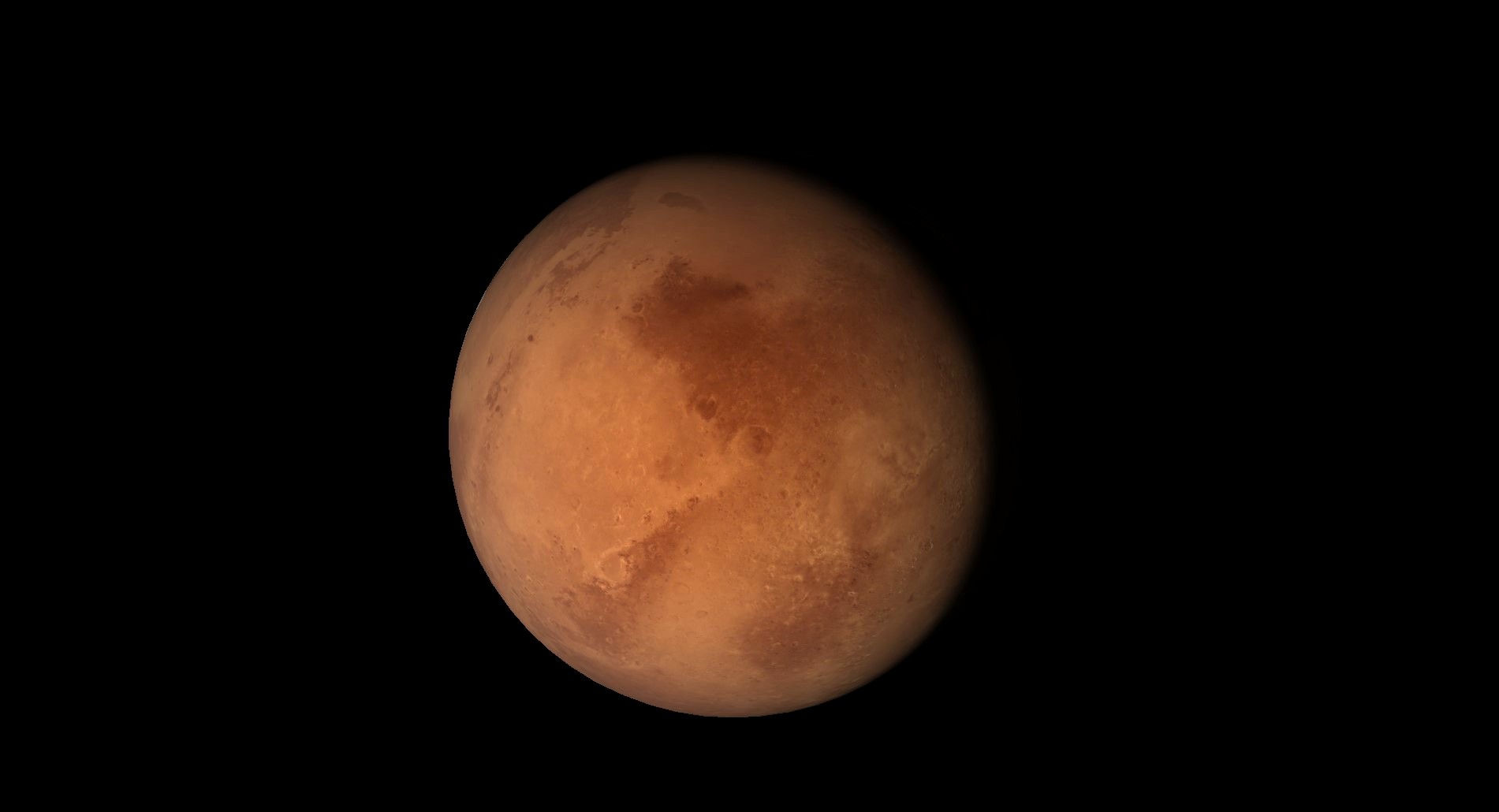
During February, Mars volition ascent at around five a.grand. local time. It will remain appreciable in the southeastern pre-dawn sky while it slowly increases its angle from the sun on its yr-long journey to opposition in late December. The ruby-red planet will be traveling due east with 300x brighter Venus positioned to its northward. Later on starting the month nine degrees apart, Venus and Mars will reach conjunction on February. 12, separated by half-dozen.5 degrees. After that, they'll travel eastward together through northern Sagittarius on parallel, gradually converging tracks. During February Mars will burnish slightly from an initial magnitude 1.4. In a telescope, its 95%-illuminated disk volition grow in size by 10%. Mars will spend early February in the eastern reaches of the Milky way. For several mornings centered on February. 1, the red planet will shine only a finger'due south width above (or i caste to the celestial northward of) the globular star cluster Messier 28. On Feb. 5, Mars will skim the northern outskirts of the Great Sagittarius Cluster (Messier 22). On Feb. eleven, Mars will pass close to the south of the pocket-size globular cluster designated NGC 6717. On Feb. 27, the quondam crescent moon will class a neat line with brilliant Venus at the top and Mars in the center, making a terrific photo opportunity when equanimous with some interesting landscape.
Jupiter

As Feb begins, Jupiter volition be visible equally a bright magnitude -ii.0 dot shining above the west-southwestern horizon after sunset. With each passing day, it will become harder to see every bit it sinks deeper into the twilight until information technology becomes lost from view later on mid-month. On Feb. two, the very thin crescent of the young moon will shine several finger-widths to the lower left (or iv.6 degrees to the celestial SSW) of Jupiter.
Saturn
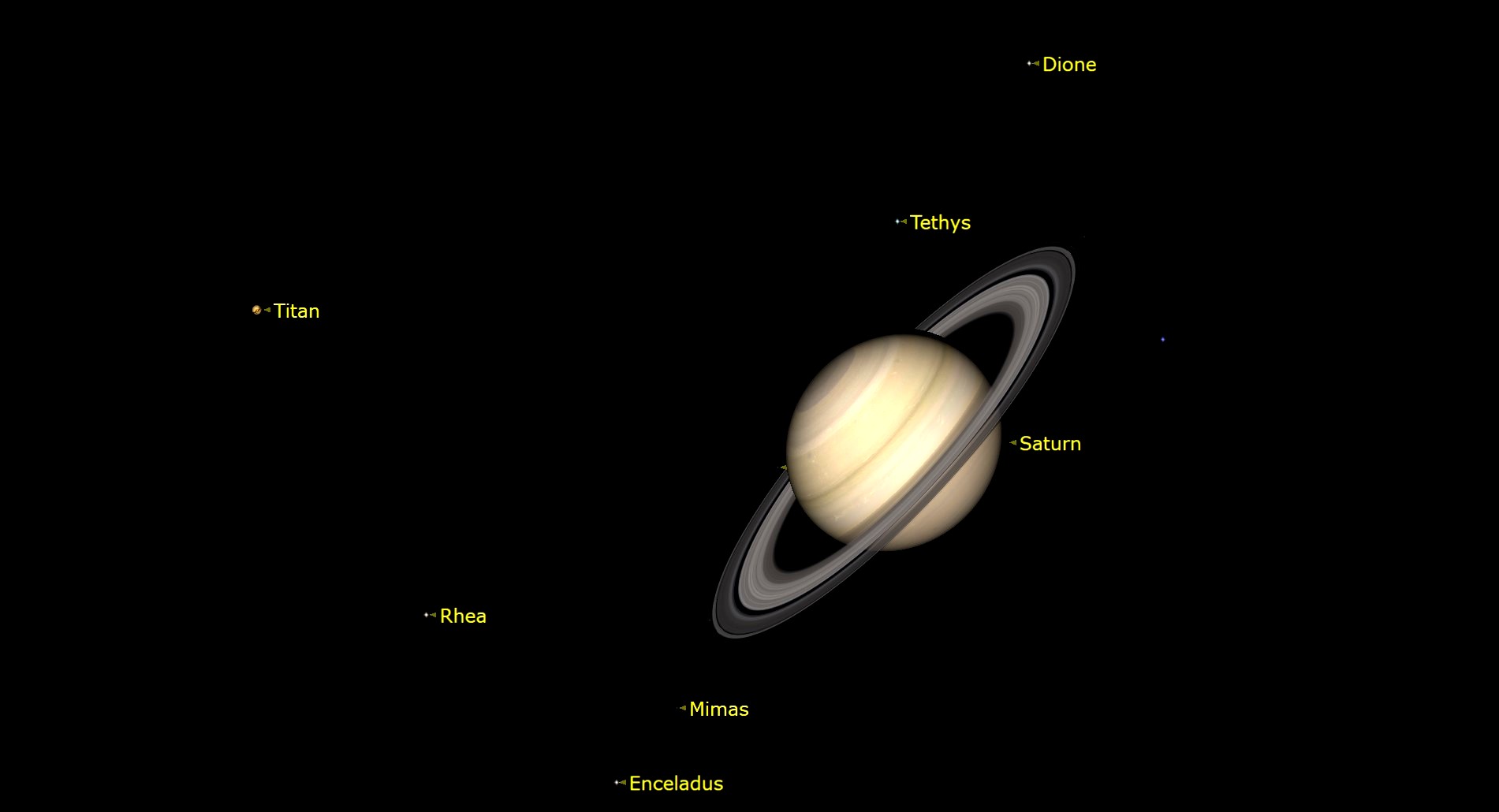
Saturn will reach conjunction with the sun on Feb. 4. It volition appear very low in the twilit southeastern pre-dawn sky — budgeted brighter Mercury from the eastward — on the final few mornings of Feb.
Uranus

Magnitude 5.8 Uranus volition be observable in binoculars and telescopes during early evening in Feb. Its small, blueish-green dot will be moving slowly retrograde westwards in southern Aries, 10.vii degrees southeast of that constellation'due south brightest stars, Hamal and Sheratan, and only v.3 degrees from the medium-vivid star Mu Ceti to its south-southeast. The planet volition exist all-time viewed correct after dusk, when information technology volition withal be about halfway upwardly the southwestern sky. On Feb. 7, the nearly half-illuminated moon will laissez passer simply ane.8 degrees to the right (celestial northwest) of the moon. Several hours earlier, effectually 19:39 GMT, observers in the southern Atlantic Body of water near Queen Maud Land can meet the moon occult Uranus — the first of 15 consecutive monthly lunar occultations of the 7th planet.
Neptune

After sunset during early February, the distant, bluish planet Neptune will sit down in the lower part of the southwestern evening sky — nigh 14 degrees above (celestial east of) Jupiter — only as well low for easy observing. The magnitude 7.9 planet will be traveling very slowly east among the stars of northeastern Aquarius. On Feb. iii the young crescent moon will shine 4 degrees to Neptune's lower left (celestial southwest). Earlier month's end, Neptune will, similar Jupiter, disappear into the post-sunset twilight.
Join our Space Forums to keep talking space on the latest missions, dark sky and more than! And if you have a news tip, correction or comment, let us know at: community@space.com.
Source: https://www.space.com/16149-night-sky.html
0 Response to "What Color House Numbers Show Best at Night"
Enregistrer un commentaire